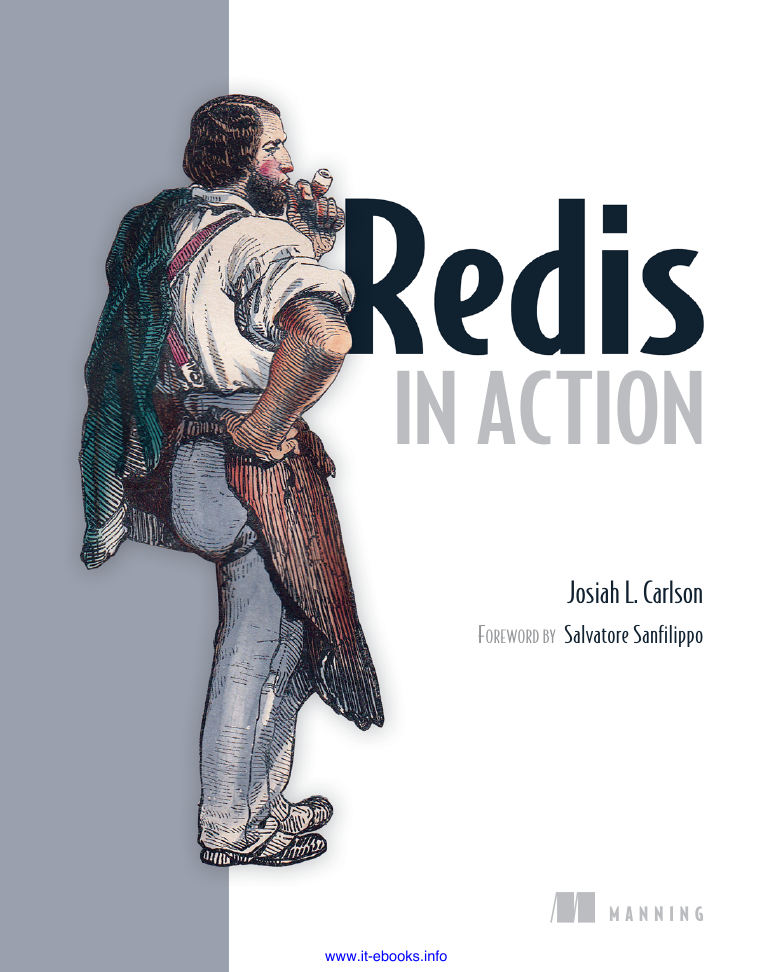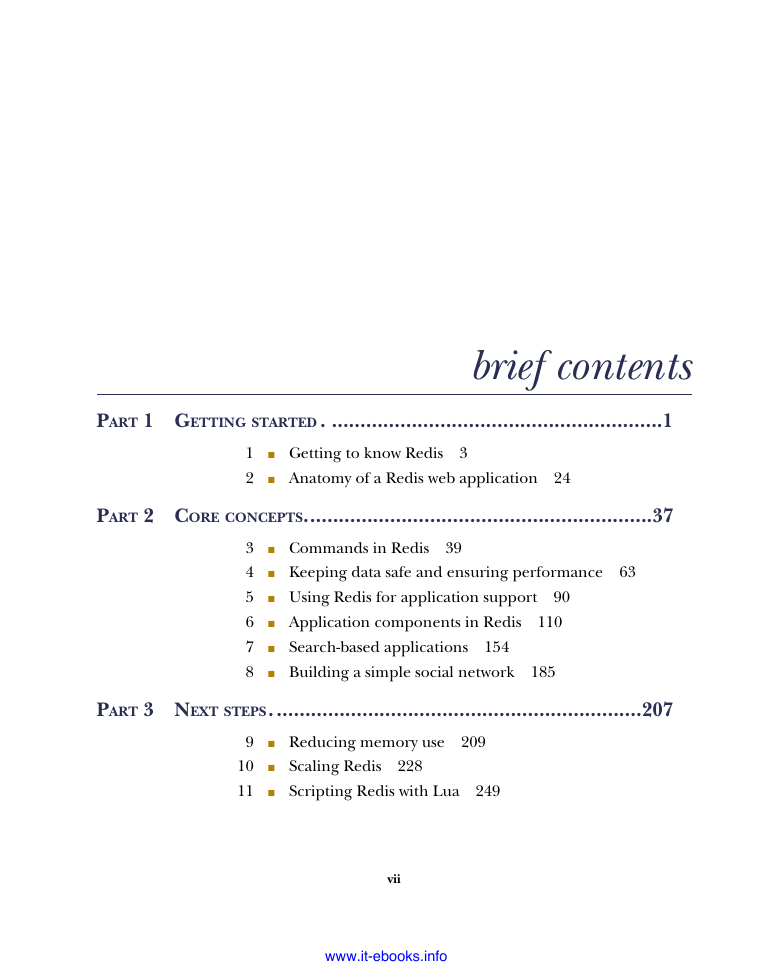Redis in Action
brief contents
contents
foreword
preface
acknowledgments
about this book
Roadmap
Code conventions and downloads
Author Online
About the author
about the cover illustration
Part 1: Getting started
Chapter 1: Getting to know Redis
1.1 What is Redis?
1.1.1 Redis compared to other databases and software
1.1.2 Other features
1.1.3 Why Redis?
1.2 What Redis data structures look like
1.2.1 Strings in Redis
1.2.2 Lists in Redis
1.2.3 Sets in Redis
1.2.4 Hashes in Redis
1.2.5 Sorted sets in Redis
1.3 Hello Redis
1.3.1 Voting on articles
1.3.2 Posting and fetching articles
1.3.3 Grouping articles
1.4 Getting help
1.5 Summary
Chapter 2: Anatomy of a Redis web application
2.1 Login and cookie caching
2.2 Shopping carts in Redis
2.3 Web page caching
2.4 Database row caching
2.5 Web page analytics
2.6 Summary
Part 2: Core concepts
Chapter 3: Commands in Redis
3.1 Strings
3.2 Lists
3.3 Sets
3.4 Hashes
3.5 Sorted sets
3.6 Publish/subscribe
3.7 Other commands
3.7.1 Sorting
3.7.2 Basic Redis transactions
3.7.3 Expiring keys
3.8 Summary
Chapter 4: Keeping data safe and ensuring performance
4.1 Persistence options
4.1.1 Persisting to disk with snapshots
4.1.2 Append-only file persistence
4.1.3 Rewriting/compacting append-only files
4.2 Replication
4.2.1 Configuring Redis for replication
4.2.2 Redis replication startup process
4.2.3 Master/slave chains
4.2.4 Verifying disk writes
4.3 Handling system failures
4.3.1 Verifying snapshots and append-only files
4.3.2 Replacing a failed master
4.4 Redis transactions
4.4.1 Defining users and their inventory
4.4.2 Listing items in the marketplace
4.4.3 Purchasing items
4.5 Non-transactional pipelines
4.6 Performance considerations
4.7 Summary
Chapter 5: Using Redis for application support
5.1 Logging to Redis
5.1.1 Recent logs
5.1.2 Common logs
5.2 Counters and statistics
5.2.1 Storing counters in Redis
5.2.2 Storing statistics in Redis
5.2.3 Simplifying our statistics recording and discovery
5.3 IP-to-city and -country lookup
5.3.1 Loading the location tables
5.3.2 Looking up cities
5.4 Service discovery and configuration
5.4.1 Using Redis to store configuration information
5.4.2 One Redis server per application component
5.4.3 Automatic Redis connection management
5.5 Summary
Chapter 6: Application components in Redis
6.1 Autocomplete
6.1.1 Autocomplete for recent contacts
6.1.2 Address book autocomplete
6.2 Distributed locking
6.2.1 Why locks are important
6.2.2 Simple locks
6.2.3 Building a lock in Redis
6.2.4 Fine-grained locking
6.2.5 Locks with timeouts
6.3 Counting semaphores
6.3.1 Building a basic counting semaphore
6.3.2 Fair semaphores
6.3.3 Refreshing semaphores
6.3.4 Preventing race conditions
6.4 Task queues
6.4.1 First-in, first-out queues
6.4.2 Delayed tasks
6.5 Pull messaging
6.5.1 Single-recipient publish/subscribe replacement
6.5.2 Multiple-recipient publish/subscribe replacement
6.6 Distributing files with Redis
6.6.1 Aggregating users by location
6.6.2 Sending files
6.6.3 Receiving files
6.6.4 Processing files
6.7 Summary
Chapter 7: Search-based applications
7.1 Searching in Redis
7.1.1 Basic search theory
7.1.2 Sorting search results
7.2 Sorted indexes
7.2.1 Sorting search results with ZSETs
7.2.2 Non-numeric sorting with ZSETs
7.3 Ad targeting
7.3.1 What’s an ad server?
7.3.2 Indexing ads
7.3.3 Targeting ads
7.3.4 Learning from user behavior
7.4 Job search
7.4.1 Approaching the problem one job at a time
7.4.2 Approaching the problem like search
7.5 Summary
Chapter 8: Building a simple social network
8.1 Users and statuses
8.1.1 User information
8.1.2 Status messages
8.2 Home timeline
8.3 Followers/following lists
8.4 Posting or deleting a status update
8.5 Streaming API
8.5.1 Data to be streamed
8.5.2 Serving the data
8.5.3 Filtering streamed messages
8.6 Summary
Part 3: Next steps
Chapter 9: Reducing memory use
9.1 Short structures
9.1.1 The ziplist representation
9.1.2 The intset encoding for SETs
9.1.3 Performance issues for long ziplists and intsets
9.2 Sharded structures
9.2.1 HASHes
9.2.2 SETs
9.3 Packing bits and bytes
9.3.1 What location information should we store?
9.3.2 Storing packed data
9.3.3 Calculating aggregates over sharded STRINGs
9.4 Summary
Chapter 10: Scaling Redis
10.1 Scaling reads
10.2 Scaling writes and memory capacity
10.2.1 Handling shard configuration
10.2.2 Creating a server-sharded connection decorator
10.3 Scaling complex queries
10.3.1 Scaling search query volume
10.3.2 Scaling search index size
10.3.3 Scaling a social network
10.4 Summary
Chapter 11: Scripting Redis with Lua
11.1 Adding functionality without writing C
11.1.1 Loading Lua scripts into Redis
11.1.2 Creating a new status message
11.2 Rewriting locks and semaphores with Lua
11.2.1 Why locks in Lua?
11.2.2 Rewriting our lock
11.2.3 Counting semaphores in Lua
11.3 Doing away with WATCH/MULTI/EXEC
11.3.1 Revisiting group autocomplete
11.3.2 Improving the marketplace, again
11.4 Sharding LISTs with Lua
11.4.1 Structuring a sharded LIST
11.4.2 Pushing items onto the sharded LIST
11.4.3 Popping items from the sharded LIST
11.4.4 Performing blocking pops from the sharded LIST
11.5 Summary
appendix A: Quick and dirty setup
A.1 Installation on Debian or Ubuntu Linux
A.2 Installing on OS X
A.3 Installing on Windows
A.3.1 Drawbacks of Redis on Windows
A.3.2 Installing Redis on Windows
A.3.3 Installing Python on Windows
A.4 Hello Redis
appendix B: Other resources and references
B.1 Forums for help
B.2 Introductory topics
B.3 Queues and other libraries
B.4 Data visualization and recording
B.5 Data sources
B.6 Redis experiences and articles
index
A
B
C
D
E
F
G
H
I
J
K
L
M
N
O
P
Q
R
S
T
U
V
W
X
Z
















 2023年江西萍乡中考道德与法治真题及答案.doc
2023年江西萍乡中考道德与法治真题及答案.doc 2012年重庆南川中考生物真题及答案.doc
2012年重庆南川中考生物真题及答案.doc 2013年江西师范大学地理学综合及文艺理论基础考研真题.doc
2013年江西师范大学地理学综合及文艺理论基础考研真题.doc 2020年四川甘孜小升初语文真题及答案I卷.doc
2020年四川甘孜小升初语文真题及答案I卷.doc 2020年注册岩土工程师专业基础考试真题及答案.doc
2020年注册岩土工程师专业基础考试真题及答案.doc 2023-2024学年福建省厦门市九年级上学期数学月考试题及答案.doc
2023-2024学年福建省厦门市九年级上学期数学月考试题及答案.doc 2021-2022学年辽宁省沈阳市大东区九年级上学期语文期末试题及答案.doc
2021-2022学年辽宁省沈阳市大东区九年级上学期语文期末试题及答案.doc 2022-2023学年北京东城区初三第一学期物理期末试卷及答案.doc
2022-2023学年北京东城区初三第一学期物理期末试卷及答案.doc 2018上半年江西教师资格初中地理学科知识与教学能力真题及答案.doc
2018上半年江西教师资格初中地理学科知识与教学能力真题及答案.doc 2012年河北国家公务员申论考试真题及答案-省级.doc
2012年河北国家公务员申论考试真题及答案-省级.doc 2020-2021学年江苏省扬州市江都区邵樊片九年级上学期数学第一次质量检测试题及答案.doc
2020-2021学年江苏省扬州市江都区邵樊片九年级上学期数学第一次质量检测试题及答案.doc 2022下半年黑龙江教师资格证中学综合素质真题及答案.doc
2022下半年黑龙江教师资格证中学综合素质真题及答案.doc